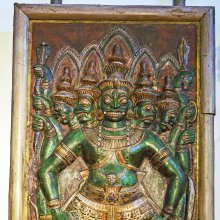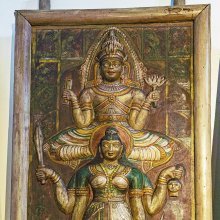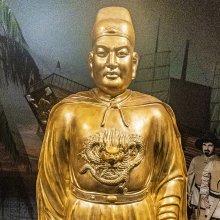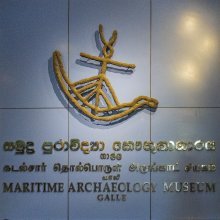Ninda, Nindā, Nimda: 23 definitions
Introduction:
Ninda means something in Buddhism, Pali, Hinduism, Sanskrit, Jainism, Prakrit, Marathi, Hindi, biology. If you want to know the exact meaning, history, etymology or English translation of this term then check out the descriptions on this page. Add your comment or reference to a book if you want to contribute to this summary article.
Images (photo gallery)
In Hinduism
Purana and Itihasa (epic history)
Source: archive.org: Shiva Purana - English TranslationNindā (निन्दा) refers to “discredit”, according to the Śivapurāṇa 2.3.27 (“Description of the fraudulent words of the Brahmacārin”).—Accordingly, after Śiva (in guise of a Brahmacārin) spoke to Pārvatī: “On hearing these words of that Brahmin, Pārvatī said angrily to the Brahmin who discredited Śiva [i.e., nindā—śivanindāparaṃ dvijam]”.
Source: Cologne Digital Sanskrit Dictionaries: The Purana IndexNindā (निन्दा).—One of the ten lakṣaṇas of a Brāhmaṇa.*
- * Vāyu-purāṇa 59. 134.

The Purana (पुराण, purāṇas) refers to Sanskrit literature preserving ancient India’s vast cultural history, including historical legends, religious ceremonies, various arts and sciences. The eighteen mahapuranas total over 400,000 shlokas (metrical couplets) and date to at least several centuries BCE.
Natyashastra (theatrics and dramaturgy)
Source: Wisdom Library: Nāṭya-śāstraNindā (निन्दा, “simile of censure”) refers to one of the five kinds of upamā, according to Nāṭyaśāstra chapter 17. Upamā (‘simile’) is one of the four “figures of speech” (alaṃkāra), used when composing dramatic compositions (kāvya).

Natyashastra (नाट्यशास्त्र, nāṭyaśāstra) refers to both the ancient Indian tradition (shastra) of performing arts, (natya—theatrics, drama, dance, music), as well as the name of a Sanskrit work dealing with these subjects. It also teaches the rules for composing Dramatic plays (nataka), construction and performance of Theater, and Poetic works (kavya).
Dharmashastra (religious law)
Source: Sacred Texts: The Grihya Sutras, Part 2 (SBE30)Nindā (निन्दा) refers to “reproof”, as found in the Brāhmaṇas, according to the Āpastamba-yajña-paribhāṣā-sūtras.—“the name Veda belongs both to the Mantras and Brāhmaṇas. The Brāhmaṇas are the precepts for the sacrifice. The rest of the Brāhmaṇa, that which does not contain precepts, consists of explanations, i.e. reproof [viz., Nindā], praise, stories, and traditions”.

Dharmashastra (धर्मशास्त्र, dharmaśāstra) contains the instructions (shastra) regarding religious conduct of livelihood (dharma), ceremonies, jurisprudence (study of law) and more. It is categorized as smriti, an important and authoritative selection of books dealing with the Hindu lifestyle.
Vedanta (school of philosophy)
Source: academia.edu: Religious Inclusivism in the Writings of an Early Modern Sanskrit Intellectual (vedanta)Nindā (निन्दा) (Cf. Śaṅkara) refers to an “offense” (to the Veda).—[...] Independent human reasoning (śuṣkatarka) or experience (anubhava) alone are not conducive to liberation. Therefore, those religious traditions that claim to be based on the inspiration of omniscient founders and/or on extra-Vedic revelations cannot be soteriologically-valid means of liberation. It is essentially on the basis of this argument that Śaṅkara refutes the authority of Buddhist, Jaina, Sāṃkhya, Yoga, Pāśupata and Pāñcarātra traditions in the second adhyāya of his Brahmasūtrabhāṣya. For instance, ad Brahmasūtrabhāṣya 2.2.45, Śaṅkara says that Śāṇḍilya studied Pāñcarātra because he did not find the highest good (paraṃ śreyas, i.e. liberation) in Vedic teachings. Śaṅkara interprets Śāṇḍilya’s attitude as an offense (nindā) to the Veda, and thus rejects the entire Pāñcarātra tradition on the basis that it stands against the Veda (vedapratiṣedha).

Vedanta (वेदान्त, vedānta) refers to a school of orthodox Hindu philosophy (astika), drawing its subject-matter from the Upanishads. There are a number of sub-schools of Vedanta, however all of them expound on the basic teaching of the ultimate reality (brahman) and liberation (moksha) of the individual soul (atman).
Shaivism (Shaiva philosophy)
Source: Brill: Śaivism and the Tantric TraditionsNindā (निन्दा) refers to “abusing”, according to the 13th-century Matsyendrasaṃhitā: a Kubjikā-Tripurā oriented Tantric Yoga text of the Ṣaḍanvayaśāmbhava tradition from South India.—Accordingly, “If he sees anybody who is abusing the Guru (guru-nindā), he should beat him or [at least] curse him. Or, if he is unable [to do so], he should leave the place. He should not ridicule the worship of the [Yoginī] clans, or despise Yogins or Yoginīs, women when they are intoxicated, or nourished, or the wine-pot, or Śiva, or the Guru”.

Shaiva (शैव, śaiva) or Shaivism (śaivism) represents a tradition of Hinduism worshiping Shiva as the supreme being. Closely related to Shaktism, Shaiva literature includes a range of scriptures, including Tantras, while the root of this tradition may be traced back to the ancient Vedas.
In Buddhism
General definition (in Buddhism)
Source: Wisdom Library: Dharma-samgrahaNindā (निन्दा, “blame”) refers to one of the “eight worldly conditions” (lokadharma) as defined in the Dharma-saṃgraha (section 61). The Dharma-samgraha (Dharmasangraha) is an extensive glossary of Buddhist technical terms in Sanskrit (e.g., nindā). The work is attributed to Nagarjuna who lived around the 2nd century A.D.
In Jainism
General definition (in Jainism)
Source: archive.org: Jaina YogaNindā (निन्दा, “remorse”) refers to an aspect of samyaktva (right belief) classified under the guṇa heading, according to various Jain authors (e.g., Cāmuṇḍarāya, Amitagati and Vasunandin). Nindā is the remorse felt by a pious man when for the sake of wife or son or brother or friend he has committed some act inspired by passion or hate (Amitagati’s Śrāvakācāra verse 2.74).

Jainism is an Indian religion of Dharma whose doctrine revolves around harmlessness (ahimsa) towards every living being. The two major branches (Digambara and Svetambara) of Jainism stimulate self-control (or, shramana, ‘self-reliance’) and spiritual development through a path of peace for the soul to progess to the ultimate goal.
Biology (plants and animals)
Source: Wisdom Library: Local Names of Plants and DrugsNimda in the Hindi language is the name of a plant identified with Buddleja asiatica Lour. from the Scrophulariaceae (Figwort) family having the following synonyms: Buddleja arfakensis, Buddleja discolor, Buddleja neemda. For the possible medicinal usage of nimda, you can check this page for potential sources and references, although be aware that any some or none of the side-effects may not be mentioned here, wether they be harmful or beneficial to health.

This sections includes definitions from the five kingdoms of living things: Animals, Plants, Fungi, Protists and Monera. It will include both the official binomial nomenclature (scientific names usually in Latin) as well as regional spellings and variants.
Languages of India and abroad
Pali-English dictionary
Source: Sutta: The Pali Text Society's Pali-English DictionaryNindā, (f.) (cp. Sk. nindā, to nindati) blame, reproach, fault-finding, fault, disgrace S. III, 73; A. II, 188; IV, 157 sq.; M. I, 362; Sn. 213 (+pasaṃsā blame & praise); Dh. 81 (id.); Sn. 826, 895, 928; Dh. 143, 309; Nd1 165, 306, 384; DhA. II, 148.—In compn nindi° see anindi°. (Page 359)

Pali is the language of the Tipiṭaka, which is the sacred canon of Theravāda Buddhism and contains much of the Buddha’s speech. Closeley related to Sanskrit, both languages are used interchangeably between religions.
Marathi-English dictionary
Source: DDSA: The Molesworth Marathi and English Dictionarynindā (निंदा).—f (S) Reproaching, censuring, accusing: also reviling or abusing. nindāparastuti or nindāphalakastutivākya Ironical praise, irony.
Source: DDSA: The Aryabhusan school dictionary, Marathi-Englishnindā (निंदा).—f Reproaching, reviling or abusing.
Marathi is an Indo-European language having over 70 million native speakers people in (predominantly) Maharashtra India. Marathi, like many other Indo-Aryan languages, evolved from early forms of Prakrit, which itself is a subset of Sanskrit, one of the most ancient languages of the world.
Sanskrit dictionary
Source: DDSA: The practical Sanskrit-English dictionaryNindā (निन्दा).—[nind-bhāve-lyuṭ a vā]
1) Blame, censure, reproof, reproach, abuse, reviling, defamation; व्याजस्तुतिर्मुखे निन्दा (vyājastutirmukhe nindā) K. P.1; पर°, वेद° (para°, veda°).
2) Injury, wickedness.
See also (synonyms): nindana.
Source: Cologne Digital Sanskrit Dictionaries: Shabda-Sagara Sanskrit-English DictionaryNindā (निन्दा).—f.
(-ndā) 1. Censure, reproach, reproof, blame, abuse, reviling, defamation. 2. Injury, injuring. 3. Wickedness. E. ṇid to abuse, &c. affixes aṅ and ṭāp or nindi bhāve a .
Source: Cologne Digital Sanskrit Dictionaries: Benfey Sanskrit-English DictionaryNinda (निन्द).—Nind see 1. nid.
--- OR ---
Nindā (निन्दा).—i. e. nind + a, f. 1. Blame, [Mānavadharmaśāstra] 8, 19. 2. Defamation, [Mānavadharmaśāstra] 2, 200. 3. Scorn, [Bhāgavata-Purāṇa, (ed. Burnouf.)] 4, 21, 6.
Source: Cologne Digital Sanskrit Dictionaries: Cappeller Sanskrit-English DictionaryNindā (निन्दा).—[feminine] the same + shame, disgrace.
Source: Cologne Digital Sanskrit Dictionaries: Monier-Williams Sanskrit-English Dictionary1) Ninda (निन्द):—[from nind] only in -tala
2) Nindā (निन्दा):—[from nind] f. blame, censure, reproach, reviling, defamation, controversy, injury, outrage, [Atharva-veda; Manu-smṛti; Mahābhārata] etc.
3) [v.s. ...] (with, [Buddhist literature]) one of the eight worldly conditions, [Dharmasaṃgraha lxi]
Source: Cologne Digital Sanskrit Dictionaries: Yates Sanskrit-English DictionaryNindā (निन्दा):—(ndā) 1. f. Censure, reproach.
Source: DDSA: Paia-sadda-mahannavo; a comprehensive Prakrit Hindi dictionary (S)Nindā (निन्दा) in the Sanskrit language is related to the Prakrit word: Ṇiṃdā.
[Sanskrit to German]
Sanskrit, also spelled संस्कृतम् (saṃskṛtam), is an ancient language of India commonly seen as the grandmother of the Indo-European language family (even English!). Closely allied with Prakrit and Pali, Sanskrit is more exhaustive in both grammar and terms and has the most extensive collection of literature in the world, greatly surpassing its sister-languages Greek and Latin.
Hindi dictionary
Source: DDSA: A practical Hindi-English dictionaryNinda in Hindi refers in English to:—(nf) ill-speaking, censure, condemnation; —[prastava] censure motion; —[stuti] censure and praise, speaking ill or well (of somebody)..—ninda (निंदा) is alternatively transliterated as Niṃdā.
...
Prakrit-English dictionary
Source: DDSA: Paia-sadda-mahannavo; a comprehensive Prakrit Hindi dictionary1) Ṇiṃda (णिंद) in the Prakrit language is related to the Sanskrit word: Nind.
2) Ṇiṃda (णिंद) also relates to the Sanskrit word: Nindya.
3) Ṇiṃdā (णिंदा) also relates to the Sanskrit word: Nindā.
Prakrit is an ancient language closely associated with both Pali and Sanskrit. Jain literature is often composed in this language or sub-dialects, such as the Agamas and their commentaries which are written in Ardhamagadhi and Maharashtri Prakrit. The earliest extant texts can be dated to as early as the 4th century BCE although core portions might be older.
See also (Relevant definitions)
Starts with (+13): Nimdanaya, Nimdane, Nimdaya, Ninda-gama, Ninda-garnu, Ninda-lekha, Nindacarca, Nindacharchaa, Nindak, Nindaka, Nindakara, Nindakhora, Nindan, Nindana, Nindanakarman, Nindanastuti, Nindanem, Nindaniy, Nindaniya, Nindanopama.
Ends with (+22): Aninda, Asvashlaghanyaninda, Atmaninda, Avanimda, Chuninda, Daridraninda, Devaninda, Dharanimda, Dinimda, Durjananinda, Gunaninda, Guruninda, Ishvaraninda, Ishwarninda, Janinda, Jinimda, Kapataninda, Kauninda, Kripananinda, Kucaninda.
Full-text (+144): Devaninda, Nindastuti, Vedaninda, Vyajaninda, Kulaninda, Shastraninda, Nindatala, Sanindam, Nindya, Vininda, Atmaninda, Nindopama, Saninda, Nind, Nimnatala, Vellaikkatampu, Nindana, Anindaniya, Nintai, Anindita.
Relevant text
Search found 41 books and stories containing Ninda, Nimda, Ṇiṃda, Ṇiṃdā, Nindā, Ṇinda, Ṇindā; (plurals include: Nindas, Nimdas, Ṇiṃdas, Ṇiṃdās, Nindās, Ṇindas, Ṇindās). You can also click to the full overview containing English textual excerpts. Below are direct links for the most relevant articles:
Hari-bhakti-kalpa-latikā (by Sarasvati Thkura)
Text 46 < [Second Stabaka]
Chaitanya Bhagavata (by Bhumipati Dāsa)
Verse 3.6.137 < [Chapter 6 - The Glories of Śrī Nityānanda Prabhu]
Verse 2.20.144 < [Chapter 20 - The Glories of Murāri Gupta]
Verse 2.5.145 < [Chapter 5 - Lord Nityānanda’s Vyāsa-pūjā Ceremony and His Darśana of the Lord’s Six-armed Form]
Dhammapada (Illustrated) (by Ven. Weagoda Sarada Maha Thero)
Verse 309-310 - The Story of Khema the Guild Leader < [Chapter 22 - Niraya Vagga (Hell)]
Verse 143-144 - The Story of Venerable Pilotikatissa < [Chapter 10 - Daṇḍa Vagga (Punishment)]
Verse 81 - The Story of Venerable Lakuṇṭaka Bhaddiya < [Chapter 6 - Paṇḍita Vagga (The Wise)]
Bhakti-rasamrta-sindhu (by Śrīla Rūpa Gosvāmī)
Verse 2.1.321 < [Part 1 - Ecstatic Excitants (vibhāva)]
Verse 1.2.121 < [Part 2 - Devotional Service in Practice (sādhana-bhakti)]
The Practice Manual of Noble Tārā Kurukullā (by Dharmachakra Translation Committee)
Chapter 4 < [Appendix - Sanskrit Text]




